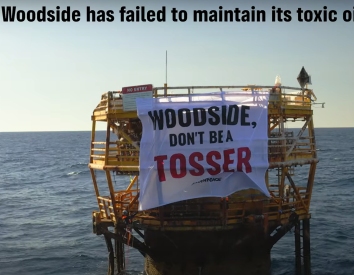Our government's insistence on using coal as an energy source can be directly linked to the catastrophic bushfire situation, writes David Ritter.
NO COAL EXECUTIVE has been found with a box of matches near one of Australia’s disastrous bushfires, but the coal industry bears some clear responsibility for the wild conflagrations that have caused so much pain and devastation across our beautiful country this spring.
The chain of causation connecting coal to the circumstances that have caused catastrophic bushfires is short.
First, the expert evidence is abundantly clear — the extent, severity and intensity of these unprecedented disastrous fires in Australia are a consequence of climate change. Extended droughts like the one we have seen in Eastern Australia over the past two years create tinderbox conditions for bushfires. These include very dry fuels and soils as well as more flammable vegetation, all of these factors have been aggravated by climate change and have contributed to the current inferno.
Second, the number one driver of the climate emergency in Australia is coal. Coal-burning power stations contributed 28.96% of Australia's total domestic CO2 emissions in the year ended June 2018 — far greater than any other single sector.
Unfortunately, there's not a single government source for this, but it's easy to calculate:
- According to the National Greenhouse Gas Inventory, total domestic emissions excluding land use, land use change and forestry for FY2018 were 555.5 million tonnes CO2e. (Negative emissions from LULUCF are usually excluded from greenhouse reporting because they are unreliable and because short-term carbon drawdown from land sinks do not fully mitigate carbon released from underground. If these were included as per Australia's Paris reporting requirements, the percentage would be higher.)
- According to the Clean Energy Regulator's National Greenhouse inventory, coal-burning power stations emitted 160.9 million tonnes CO2e in FY2018. (The coal contribution only includes power stations connected to the east coast and WA grids and doesn't include the smaller amount of coal burnt at private facilities including industry and hospital boilers.)
- 160.9/555.5 = 28.96%
Globally in 2018, coal-fired electricity generation accounted for 30% of CO2 emissions and coal power facilities were the single largest contributor to the growth in emissions. Australia is the largest coal exporter in the world and is responsible for more than a quarter of world trade.
So, it is fair to say that coal is the single greatest driver of the climate emergency that has led to Australia’s catastrophic spring fire season.
Are the executives of the coal companies warned about the probable impacts of their activity?
As the Climate Council noted in a briefing paper published last week:
‘For well over 20 years, scientists have warned that climate change would increase the risk of extreme bushfires in Australia.’
The list of warnings is extensive, coming from teams of expert analysts, universities, national and global scientific bodies. The warnings and projections of the experts have been corroborated both by the data of changing weather patterns and biophysical conditions. According to the CSIRO and the Bureau of Meteorology, there has been a long-term increase in extreme fire conditions and the length of bushfire seasons in Australia.
Then there’s the first-hand experience of the most experienced firefighters. As former NSW Fire and Rescue Commissioner Greg Mullins said last week:
“Unprecedented” is a word that we are hearing a lot: from fire chiefs, politicians, and the weather bureau. If anyone tells you, “This is part of a normal cycle” or “We’ve had fires like this before”, smile politely and walk away, because they don’t know what they’re talking about.
So, did the coal executives understand the consequences of their actions? As the greatest drivers of global warming it seems not unreasonable to think that coal executives would be briefed on the probable consequences of the conditions which they were the most responsible for exacerbating.
It seems likely that the chiefs of the coal industry either knew – or should have known – that their activities were setting Australia up to burn.
But coal’s responsibility for worsening Australia’s fire disasters has another dimension. Coal has institutionally corrupted democracy — thwarting our government’s ability to enact policy to reduce greenhouse gas emissions.
As one Australian legal academic told the New York Times last week, the coal industry is to climate change what the national rifle association is to gun violence in the USA. In other words, the coal industry has done everything possible to thwart decent and effective climate and energy policy to protect their profits. And now our country is burning.
Amidst the carnage fire conditions last week, the Australia Financial Review reported that coal and gas executives had secured ‘high-level meetings with Prime Minister Scott Morrison and his senior ministers in recent days and weeks’ seeking more federal subsidies for carbon capture and storage (CCS) boondoggles. Already, coal and other fossil fuel companies receive $29 billion of subsidies in public money in Australia every year — yet with the country on fire, here they were, back for more.
In contrast, the Prime Minister has found no time to meet with the 23 former fire and emergency leaders who have been trying to brief him for months on the grave dangers facing our country.
As Greg Mullins said last week:
“We have tried since April to get a meeting with the Prime Minister. It's clear now we won't get that meeting.”
The catastrophic fire conditions experienced by Australia this spring are a symptom of the climate emergency. It is essential that the world stops burning coal as quickly as possible to avoid runaway global warming. Fortunately, clean power from sources of renewable energy is now the better option by all measures, including being cheaper and, when paired with storage, more reliable than fossil fuels.
A study conducted by UTS found that it would be possible to shift to 100% clean energy in Australia by 2030, while another by a second research team at ANU gave the slightly later date of 2032.
How much more of our country will burn in the future will largely depend on how quickly the world can leave the dirty old technology of coal behind and shift to reliable clean energy.
David Ritter is CEO of Greenpeace Australia Pacific, adjunct professor at Sydney University and an honorary fellow of the Law Faculty at the University of Western Australia. You can follow David Ritter on Twitter @David_Ritter.
 This work is licensed under a Creative Commons Attribution-NonCommercial-NoDerivs 3.0 Australia License
This work is licensed under a Creative Commons Attribution-NonCommercial-NoDerivs 3.0 Australia License
Support independent journalism Subscribe to IA.












